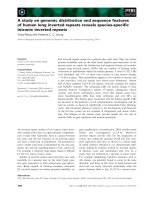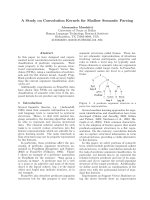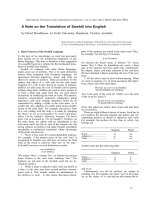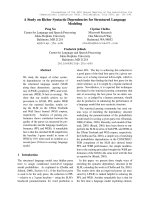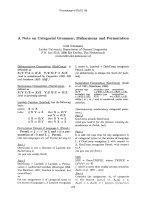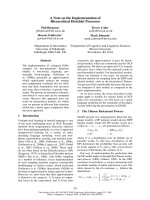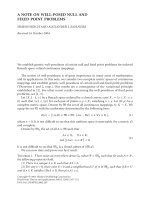Báo cáo khoa học: "A Note on Categorial Grammar, Disharmony and Permutation" doc
Bạn đang xem bản rút gọn của tài liệu. Xem và tải ngay bản đầy đủ của tài liệu tại đây (123.79 KB, 2 trang )
Proceedings of EACL '99
A Note on Categorial Grammar, Disharmony and Permutation
Crit
Cremers
Leiden University, Department of General Linguistics
P.O. box 9515, 2300 RA Leiden, The Netherlands
Disharmonious Composition (DishComp) is
definable as
X/YY\Z ~ X\Z Y/Z X\Y=. X/Z
(and is comdemned by Carpenter 1998:202
and Jacobson 1992: 139ff)
Harmonious Composition (HarmComp)
defined as
X/YY/Z =~ X/Z Y\Z X\Y~ X\Z
(and is generally adored)
is
Lambek Calculus (Lambek) has the following
basis:
axiom: X =* X
rules: if X Y ~ Z
if X =v Z/Y
if X =~ Z\Y
then X =~ Z/Y
and Y ~ Z\X
then X Y =~ Z
then Y X ::~ Z
Permutation Closure of language L (PermL)
PermL = { s [ s' in L and s is a per-
mutation of s'} and L C_ PermL
(but nice languages are not PetroL for any L)
Fact 1
DishComp is not a theorem of Lambek but
HarmComp is
(as you can easily check)
Fact 2
DishComp + Lambek = Lambek + Permu-
tation = undirected Lambek (Moortgat 1988,
Van Benthem 1991; Lambek is maximal, but
contextfree)
For any assignment A of categorial types to
the atoms of language L, if Lambek recognizes
L under A, Lambek + DishComp recognizes
PermL under A
(so disharmony is always too much for Lam-
bek)
Generalized Composition (GenComp) (Joshi
et al. 1991. Steedman 1990)
primary type secondary type composition
x/Y ( (YIZ,) )lZo~( (XlZ,) )lZn
secondary type primary type composition
( (YIZ~) )IZn X\Y =~( (XIZ~ ) )IZ~
while I is \ or / and is conserved under com-
position.
(Summarizing combinatory categorial gram-
mar:)
Fact 3
GenComp entails DishComp
(and you need it for the famous crossing de-
pendencies in Dutch, but)
Fact 4
It is not the case that for any assignment A
of categorial types to the atoms of language
L, if GenComp recognizes L with respect to
A, GenComp recognizes PermL with respect
to A
(as you can see from:)
MIX
MIX = PermTRIPLE, where TRIPLE =
{anbncn: n>
0}
(- which is more than mildly context-sensitive;
Joshi et al. 1991 - and)
Fact 5
Consider the assignment Ab of categories
to the lexicon {a,b,c} s.t. Ab(a) = a,
Ab(C) = c, Ab(b) = { (s/a)/c, ((s/a)/c)/s,
273
Proceedings of EACL '99
, ((s\c)/s)ka, ((sks)kc)ka, (skc)ka}, i.e.
Ab(b) = {slxly, slvlwlt [ {x,y) = {a,b),
{v,w,t} = {a,c,s} and l is \ or /}; b, then,
is said to be fully functional, since it has all
relevant functional types.
GenComp does not recognize
MIX with
respect to assignment
Ab.
For example: GenComp does not derive
baaccb and abaaccbcb with respect to Ab
Fact 6
Let Abc(a)= Aba, Abe(b) = Ab(b), Abc(C)
= { (s/a)/b, ((s/a)/b)/s, , ((s\b)/s)\a,
((sks)kb)ka, (skb)ka } (both b and c are
fully functional).
GenComp recognizes
MIX with
respect
to assignment Abc.
(Now consider the grammar exhibiting the fol-
lowing features.)
Primitive Cancellation Constraint
X/Y Y ~ X iff Y is primitive
(- in order to be more restrictive - and)
Directed Stacks (example)
(((X\Y)/W)\U)/V is written as
x\[u,Y]/[v,w]
(- in order to be more transparent - and)
Transparent Primary Category (examples)
Xk[A]/[Y,B] Yk[C]/[D] :~ Xk[A,C]/[B,D] or
X\[A]/[Y,B] Yk[C]/[D] =~ Xk[C,A]/[B,D] or
Xk[A]/[Y,B] Yk[C]/[D] ~ Xk[A,C]/[D,B] or
Xk[A]/[Y,B] Yk[C]/[D] =~ Xk[C,A]/[D,B]
(- in order to gain ezpressivity - make Gen-
Comp into)
Categorial List Grammar (CatListGram)
(Cremers 1993 and at fonetiek-
6.1eidenuniv.nl/hijzlndr/delilah.html)
GenComp + Primitive Cancellation Con-
straint + Directed Stacks + Transparent Pri-
mary Category
(but nevertheless)
CONCLUSIONS
None of the additional characteristics for
CatListGram affects the weak capacity of a
categorial grammar; i.e.:
• exclusive cancellation of primitives does
not affect recognition capacity
maintaining more than one argument
stack does not affect recognition capac-
ity
merging argument stacks of primary and
secondary category does not affect recog-
nition capacity
and it takes more than disharmony to induce
permutation closure.
References
Benthem, J. van, Language in Action, North
Holland, 1991
Carpenter, B., Type-Logical Semantics, MIT
Press, 1997
Cremers, C., On Parsing Coordination Cat-
egorially, HIL diss, Leiden University, 1993
Jacobson, P., 'Comment Flexible Catego-
rial Grammars', in: R. Levine (ed.), Formal
grammar: theory and implementation, Oxford
Univ. Press, 1991, p. 129- 167
Joshi, A.K., K. Vijay-Shanker, D. Weir,
'The Convergence of Mildly Context-Sensitive
Grammar Formalisms', in: P. Sells, S.M.
Shieber, T. Wasow (eds), Foundational Issues
in Natural Language Processing, MIT Press,
1991, pp. 31 - 82
Moortgat, M., Categorial Investigations,
Foris, 1988
Steedman, M., 'Gapping as Constituent Co-
ordination', Linguistics and Philosophy 13, p.
207 - 263
Fact 7
Fact 4, Fact 5 and Fact 6 also hold mu-
tatis mutandis for CatListGram. In these
aspects, CatListGram and GenComp are
weakly equivalent.
274
